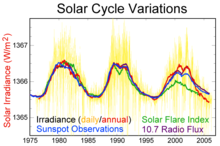Sunspots and the sunspot cycle

When observing the Sun with appropriate filtration, the most immediately visible features are usually its sunspots, which are well-defined surface areas that appear darker than their surroundings because of lower temperatures. Sunspots are regions of intense magnetic activity where convection is inhibited by strong magnetic fields, reducing energy transport from the hot interior to the surface. The magnetic field causes strong heating in the corona, forming active regions that are the source of intense solar flares and coronal mass ejections. The largest sunspots can be tens of thousands of kilometers across.
The number of sunspots visible on the Sun is not constant, but varies over an 11-year cycle known as the solar cycle. At a typical solar minimum, few sunspots are visible, and occasionally none at all can be seen. Those that do appear are at high solar latitudes. As the sunspot cycle progresses, the number of sunspots increases and they move closer to the equator of the Sun, a phenomenon described by Spörer's law. Sunspots usually exist as pairs with opposite magnetic polarity. The magnetic polarity of the leading sunspot alternates every solar cycle, so that it will be a north magnetic pole in one solar cycle and a south magnetic pole in the next.

The solar cycle has a great influence on space weather, and is a significant influence on the Earth's climate since luminosity has a direct relationship with magnetic activity. Solar activity minima tend to be correlated with colder temperatures, and longer than average solar cycles tend to be correlated with hotter temperatures. In the 17th century, the solar cycle appeared to have stopped entirely for several decades; few sunspots were observed during this period. During this era, known as the Maunder minimum or Little Ice Age, Europe experienced unusually cold temperatures. Earlier extended minima have been discovered through analysis of tree rings and appear to have coincided with lower-than-average global temperatures.